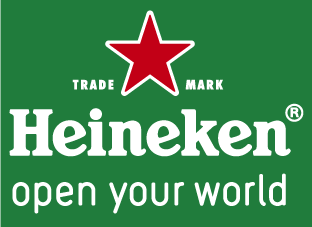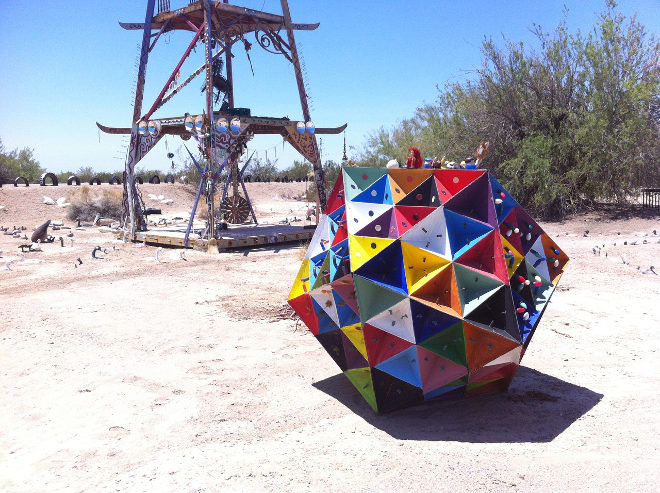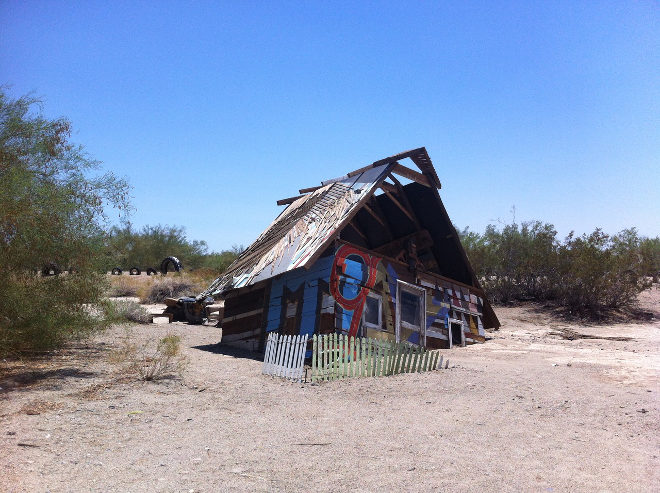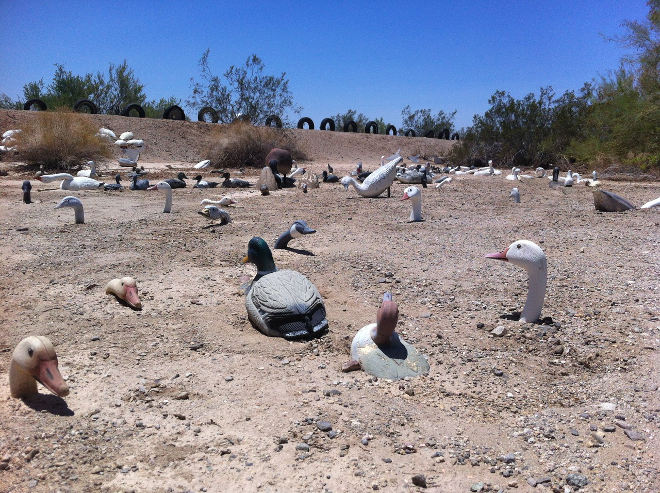Here’s What It’s Like To Live In A Sustainable Art Installation That’s Being Slowly Swallowed By The Desert
We met a guy who lived there for a year.


Open Your City with
We’ve teamed up with Heineken to introduce you to some men and women who have chosen to go beyond their borders, challenge the status quo, say ‘why not?’ instead of ‘it can’t be done’ — and as a result have made the world a more interesting place for the rest of us. For more people worth watching, head here.
–
Typically, when we think of an art installation, we think of a gallery space: calm, protected from the elements, climate controlled, security cameras dotted around the perimeter. Even at the more extreme fringes of installation art — where the ground is ripped up to form a giant wound, or rocks are piled into a metaphysically-challenging formation — the works are usually transient; designed to provoke thought in a finite period of time, be documented, and disappear.
Imagine a place, then, where the art installation is the habitat; a sprawling piece of land in the middle of nowhere where art works can be retired, devised, altered, invented or just plain admired, all the while under the watchful eye of a ragtag band of curators and a few thousand scorpions.
That place is East Jesus, founded in 2006 by the late, legendary Charles “Container Charlie” Russell and described by its inhabitants as “an experimental, habitable, extensible artwork in progress”. It sits on the outskirts of Slab City, a community that sprung up on a disused military site about six kilometers northwest of Niland in California’s south eastern desert, near the immense, eerie Salton Sea.
You might remember Slab City from Into The Wild; in Sean Penn’s 2007 film, Christopher visits Salvation Mountain, the glorious folk art monument that makes Slab City easy to spot from far around. East Jesus isn’t so easy to see from afar, but its reputation had well and truly bewitched Rene Calejo just one year after Into The Wild’s release.
“I’d gone to Slab City sometime in 2008 to see Leonard Knight’s Salvation Mountain, and overheard a few people talking about ‘Container Charlie’ and the place he was building out on the far end of the Slabs,” he recalls. Three or so years later, Calejo found himself being drawn back to the place beyond the concrete. “I’d been trying to make a go at living in LA, and failed miserably at it. Mentally, emotionally, and financially, I couldn’t keep up with the pace of living there and was desperate for a change. Then I discovered that Charles had passed away a few months earlier. His friends, not wanting to see everything he had worked for just die with him, but also being the respectable sorts with jobs and commitments of their own, sent out a call for people to help maintain East Jesus, and I figured, why not?”
Ironically enough, it was around that same time that I had discovered East Jesus, albeit from afar. Considering a trip to off-grid communities across America, I had found a tiny listing for it on the WWOOF (willing workers on organic farms) USA site, calling for itinerant helpers, curators and even gardeners to help Charlie run the joint. As fate would have it, my internet friend Rene was in the process of moving in.
As he found, maintaining a sustainable art installation in such an extreme environment came with a unique set of challenges. “With most of EJ open to the elements, everything is in a perpetual state of slow collapse,” Rene tells me. “Anything made out of metal is going to rust. Anything painted is going to fade. Anything made out of plastic is going to warp. Anything built in EJ is done so with the understanding that the desert is eventually going to swallow it whole, and the best you can do is delay that process somewhat. But, in keeping with Slab City’s philosophy of ‘salvagepunk’ and ad hoc tech, nothing goes to waste. If a particular installation falls to pieces, those pieces can be added onto another existing installation, or rebuilt into something else entirely. Everything in EJ, from the artwork to the infrastructure, is in a persistent state of flux and mutation.”
“Open to the elements, everything is in a perpetual state of slow collapse. Anything built in East Jesus is done so with the understanding that the desert is eventually going to swallow it whole.”
I discovered that first-hand when I visited Rene at the height of summer in 2012. It was a searing 46-degrees without so much as a breeze (the bag of ice I had brought as an offering of good faith very quickly turned into a sac of lukewarm water). As he showed me around the various installations, you could just about hear the paint sizzling in the sun; I wondered whether one piece, a field of semi-submerged plastic duck decoys, might begin to pop like blisters. It wasn’t an unwarranted concern.
“One of the most popular pieces in the art garden is Joe Holliday’s Definition of a Grievance, this big-ass elephant sculpture made out of blown-out car tires over a steel frame,” Rene tells me. “I say ‘big-ass’ instead of its actual size because its dimensions are variable, given that the sun constantly sloughs off the rubber, giving it a new appearance, new angles, every time you see it. There’s a level of dynamic transformation there that you don’t get with traditional artwork kept safe behind glass.”
Dynamic transformation is well and good for artworks, but for human beings it’s another thing altogether, and after a year in the desert, it was time for Rene to move on as East Jesus resident. “Simply put, the desert does not want you in it, and it has a shit ton of ways to make you want to leave: you’re always checking your bunk space for venomous spiders at night, and your shoes for scorpions in the morning. There’s no overstating the effects of the combination of isolation and extreme temperatures. Think The Shining, but really, really, really, hot.”
Despite its more onerous qualities, East Jesus left a lasting impression on Rene, so much so that he’s preparing to visit again next month. “One thing about East Jesus is that it reminds you that there are things of real and raw beauty, of deep meaning, in the places where you least expect it,” he says. “It encourages you to explore what else may be out there, and if you can’t find it, then fucking build it. The ground where EJ’s located used to be the biggest dumping site in the Slabs before Charlie Russell plopped a shipping container in the middle of it and got to work.”
–
To read more about East Jesus, head here.
–


